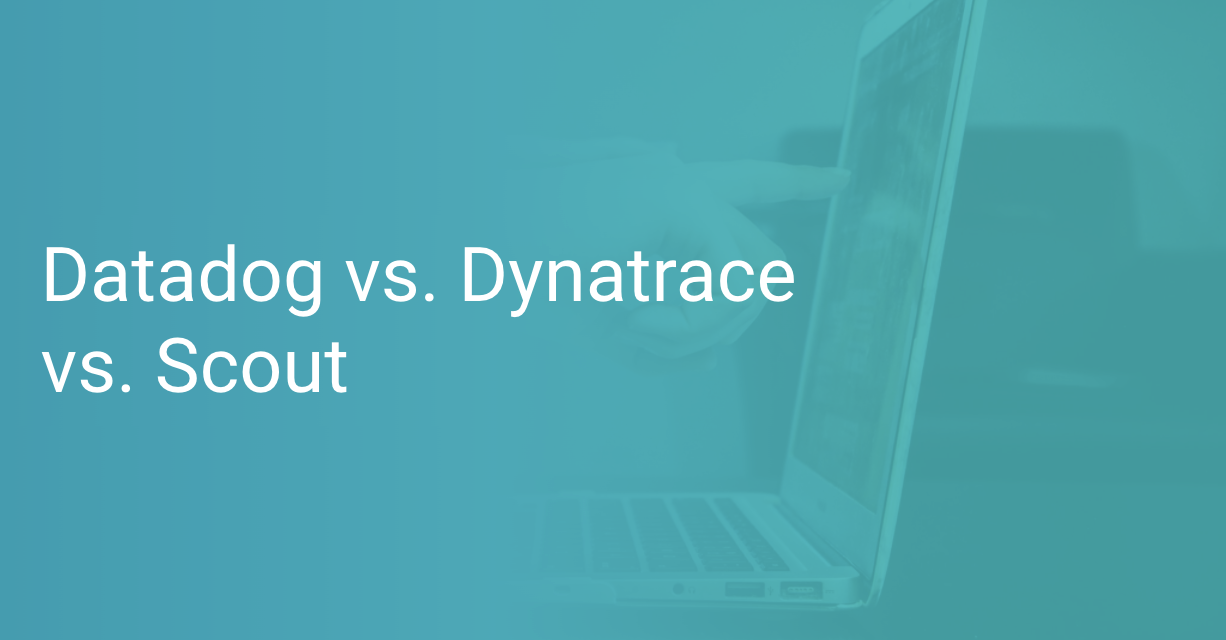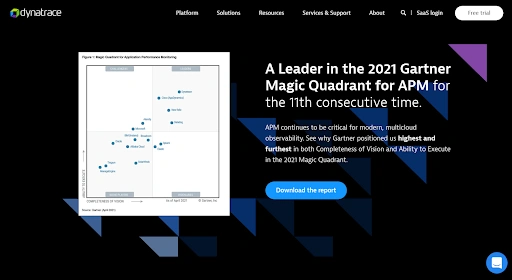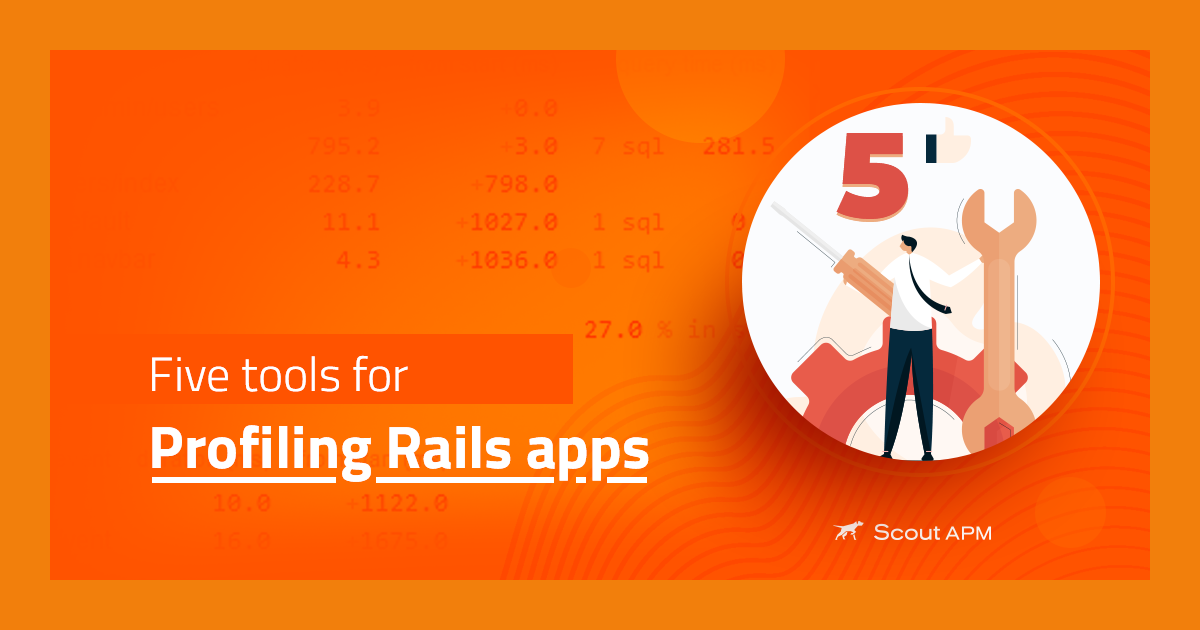Datadog vs. Dynatrace vs. Scout

Application Performance Monitoring is undoubtedly the hottest tool to accelerate any product’s growth in the modern market. The term has grown from a simple performance tracking operation to full-fledged infrastructure, network, and application observability. This evolution has only helped bring more and more growth into products.
It is essential to choose the best-suited monitoring solution for your apps since observability involves way too many moving pieces. To help in your pursuit of the best monitoring tool, we have compared three popular choices—Datadog, Dynatrace, and Scout—for you. We have covered all of the essential details about the three tools, divided by our benchmarks for comparison.
Feel free to use these links to navigate our guide.
- Background
- Overview of Differences
- Comparing APM Features
- Usability
- Dashboards & User Interface
- 3rd Party Integrations
- Installation
- Support
- APM Tools: A Developer’s Best Friend
Background
Before comparing the three platforms against each other, it is vital to understand them independently. Not all products are the same, and pitting them against a standard series of benchmarks might not bring their unique history and feature set to light.
What is an APM?
Application Performance Monitoring (APM) is a solution used to enhance observability across the various performance metrics of an application. APM solutions help keep track of the health metrics of the application while it develops and once it deploys. If you notice any abnormalities in any metrics, you can assign your team to work and fix the issue.
Some APMs take this up a notch by predicting the trends in the metrics and notifying you of errors before they happen.
Why do you need an APM?
Monitoring is a crucial part of the software deployment process. Once your app is out in the market and users start signing up, you need to know how things are going for them and your app. It is practically impossible to write perfect code at once; hence, APMs help identify your code’s flaws before they take your application or your user base down.
In most cases, APMs offer more than just recording metrics of your applications. Products like Scout APM can go so far as to tie issues with their underlying causes in the source code and couple it with the git blame output to identify who can resolve it faster. Hence, it makes your life much more manageable.
What is Datadog?
Datadog is a monitoring and analytics service that you can use for performance and event monitoring of IT infrastructure and cloud services. With Datadog, monitoring services like servers, databases, and tools is a breeze. You can deploy Datadog on-premise or as a SaaS solution.
Datadog is known to use a Go-based agent, and its backend infrastructure comprises Apache Cassandra, PostgreSQL, and Apache Kafka. It offers an easy-to-use REST API to integrate it with multiple services, programming languages, and tools.
What is Dynatrace?
Dynatrace is an application performance monitoring solution that uses artificial intelligence to break down complex monitoring processes and provide deeper insights into the application. Dynatrace has much more to offer than a simple APM solution, and it can fathom all sides of the observability of an application simultaneously.
Most of Dynatrace’s features are cloud-based, and it is famous for imbibing innovation in its approaches. You get collaboration features for all of your team members on the same platform. On the whole, Dynatrace is one of the most robust options in the APM market for those with a generous budget.
What is Scout?
Scout APM is a monitoring tool that offers the best observability and analytics over applications built using Rails, Python, Node.js, and PHP. Scout provides a clean and easy-to-use interface for developers. One of the most vital points about Scout is its robust tracing and alerting capabilities. It ensures that you never miss out on anything noteworthy that happens in your application.
Scout is known for its intricate APM solution for Ruby on Rails applications. It can detect anomalies such as N+1 & slow queries and can track ActiveRecord metrics and more. With Scout, you can identify and fix any performance issues as and when they occur.
Overview of Differences
If we talk about the overall value that these tools provide, all three of them are neck and neck. But it is not as simple as it looks.
Datadog is a solid choice if you are looking for a standard, conventional APM service with the most common features readily available. If you have a larger budget and aim for your project, you might want to try out Dynatrace for all the excellent AI and automation they offer. If you’re looking for a more customized, dedicated experience with your APM provider, Scout is your unbeaten champion!
Comparing APM Features
The first benchmark in our comparison of these three tools is the range and variety of features they offer. Identifying and assessing the core features of a product are essential before investing in it.
Another essential thing to keep in mind when looking at the features offered by a product is the proper sync between its offerings and your needs. In most cases, products offer a generalistic array of features to cater to the needs of a broad audience. However, too wide of coverage via features can result in a loss of quality in your experience. This is why finding an APM product that is most similar to your set of requirements is vital.
Datadog’s APM Features
Datadog offers a wide range of features to maintain its top position in the observability market. Here are some of the major features provided by Datadog.
Infrastructure Visibility
With Datadog, it is effortless to gain visibility into your application infrastructure. You can integrate the Datadog agent in any container or host and collect data on how your complete application stack is performing. There are no restrictions on host operating systems or environments—Datadog can make it work with anything!
APM & Continuous Profiling
A segment where Datadog shines is application performance monitoring and continuous profiling. With Datadog, it is possible to gain code-level visibility into every request. It helps you get actionable insights with automated code analysis.
Network Monitoring
With Datadog, you can monitor devices and traffic flows and gain complete network visibility into your infrastructure. You can watch and analyze the flow of data between your hosts, processes, services, and containers. You can also track system-wide DNS performance.
Security Monitoring
Datadog offers out-of-the-box custom detection rules for detecting threats in the ingested app data. You get a security dashboard to monitor the safety associated with ingested data regardless of how long it is supposed to be retained.
Incident Management
Datadog can help you detect, triage, and track incidents without any context-switching. You can assess the severity of each incident and call in relevant resources for an appropriate response. Datadog also allows you to collaborate directly in the app and across your favorite communication tools such as Slack to get the fastest response to each incident.
Dynatrace’s APM Features
Dynatrace feels like an APM of the future, packed with features that can look through your application easily. Dynatrace couples complete application and database coverage with artificial intelligence, making the locating and fixing of issues effortless.
End-User Experience Monitoring
Dynatrace offers a series of end-user experience monitoring capabilities, grouped under three categories—
- User Experience Monitoring: A browser-based injection into the app's front-end to monitor how users are using it. A similar injection is available for mobile apps too.
- Synthetic Monitoring: Analyzes app performance at different locations around the world. It helps to figure out location-based trends in usage differences.
- Data Center Real User Monitoring: Analyzes incoming web requests to monitor the latency faced by the end-users. It eliminates the need for in-app injection.
Component Deep Dive Monitoring
Dynatrace allows you to perform component deep-dive monitoring for your Java, .NET, PHP, Node.js, C/C++, iOS, or Android applications. You can collect stack traces for all transactions that occur in your app and use them to navigate through the requests easily. This feature is especially useful in tracking the source of a strange or irregular error.
Transaction Profiling
Dynatrace is among the first APM providers to introduce transactional profiling. Dynatrace provides a limited stack trace for transactions that show only the topmost entries. This reduces clutter and helps in drilling deep into the traces.
Analytics & Logging
Dynatraces handles logging and analytics in a separate service called PureLytics. PureLytics utilizes ElasticSearch for real-time analysis and processing of data. The ELK configuration makes it easy to understand and organize reports for users of all experience levels.
Scout’s APM Features
Scout is popular for extensive database & application monitoring and accurate alerting. Let’s take a deeper look into some of its striking features.
Application Performance Monitoring
Application performance monitoring is one of the fundamental pillars of observability in any real-world application. Scout’s APM service is among the top in the industry at the moment. The APM clubs together detailed monitoring, tracking, and alerting capabilities to give you a top-class monitoring experience. On top of this, Scout offers a minimalistic design to easily help you find your way in the tool.
Database Monitoring
The database is an essential component of any application ecosystem. Scout helps to analyze database query performance and also shares insight on the execution of individual queries. These two types of information together help to identify issues and performance bottlenecks in the database. You can identify problems like zooming and capacity overload quickly with Scout’s help.
Detailed SQL Analytics
If your app relies on an SQL database, you are in great luck. Scout provides highly intricate SQL metrics to help you locate and fix SQL-specific bottlenecks and leaks, which can be tricky to identify otherwise. Scout collects application transaction traces across all of your endpoints and background jobs and helps you pinpoint where you are losing on performance.
Memory Bloat Detection
Another common issue faced by poorly tested apps is memory bloat. Memory bloat refers to a situation in which the garbage collection process does not free memory quickly enough, and the slowness accumulates a large amount of garbage over a high number of requests. It can sometimes grow so big that entire servers crash and need to be restarted. Scout can help you identify this issue way before it does any harm to your production servers.
Endpoint Performance Monitoring
Other than database and memory leaks, endpoints are a major source of performance issues. It’s vital to ensure that the endpoints connecting your app’s frontend to its backend are not running out of capacity. Scout helps you keep a check on this using metrics tracked for specific controller actions and background runners. You can sort and filter the metric traces by various categories such as response time, date, count of object allocations, etc.
Auto Instrumentation
Sometimes you are required to write custom code for transactions in your app. This code can become a source of errors if not tested and monitored properly. The auto instrumentation feature of Scout APM helps by breaking down the time spent in custom code segments separately without the need to add instrumentation manually.
Analytics & Logging
Analytics is one of the strongest points of Scout APM. You can get real-time noise-free logging and alerts for all events in your app. The analytics dashboard is simple and easy to use, and you can customize it to dive into the metric traces. This helps to identify the lines of code causing issues. You can also overlay issues with git blame output so that you know who to contact to fix the faulty parts.
Bottom Line
Based on the core features of the three tools that we discussed above, here’s the gist:
- Datadog is a good alternative for mid to large-sized companies, considering its customization and modular features.
- Dynatrace offers some state-of-the-art features and suits best to the requirements of a large-scale organization with a generous budget.
- Scout offers highly dedicated and simplistic features and is among the most suitable choices for small to medium-sized organizations.
Usability
One of the key factors when deciding on any software tool is its usability. You can get the same features from various tools, but each of them has its own unique way of organizing things. The ultimate goal is to make the tools easy to use and accessible for users of all kinds.
Datadog Usability
Datadog offers a great line of features that make it highly useful to any monitoring scenario. You can get log management and application monitoring all in one place. You also get a fairly long range of third-party integrations that you can use to connect to most of the external services and work seamlessly.
However, Datadog is notorious for sending unnecessary alerts, and removing or updating resources in Datadog can be cumbersome.
Dynatrace Usability
Dynatrace is a powerful tool in itself, owing to its deeply rooted AI and automation capabilities. However, it lacks ease of use. It offers two interfaces—a local client and a web app. The web app displays high-level information about your app performance, and you need to switch to the local client if you need details about any particular issue. This non-uniformity presents an uncomfortable situation for users.
Scout APM Usability
Scout APM is popular for its simplicity and usability. Built for developers by developers, Scout takes care of the most common productivity issues by itself. It presents a low-clutter interface that packs enough power to get your jobs done efficiently.
To maintain uniformity in its interface, Scout offers a web-app-based interface that you can access by any web browser and displays the same, detailed information about your app whenever you access it.
Bottom Line
Datadog and Scout are evenly matched when it comes to getting value out of your APM tool. Dynatrace is not far behind, but it is known to get clunky at times.
Dashboards & User Interface
Dashboards are a vital component of any observability tool. It is as important to display data appropriately as it is to collect it from the right sources and points. The ease of finding the right insights and information from the raw pp data provides teams with the power to thrash bugs easily.
Datadog Dashboards
Datadog offers a rather advanced user interface with a slick look. The UI helps in tracking issues, bugs, etc, and application monitoring as well. You can easily search, add, and delete items as needed. You can also customize your dashboards according to different kinds of metrics. Other than that, Datadog also provides other widgets like AlertGraph, AlertValue, CheckStatus, GoMap, etc.
However, one of the drawbacks is that many integrations are present in the interface by default, which can sometimes make the web app slow.
Dynatrace Dashboards
While Dynatrace offers some of the most powerful, game-changing features in the industry, it lags behind the other two in terms of the organization of its user interface. Many users report that the Dynatrace UI is clunky and can get complex at times. It has also been rather difficult to customize the UI as needed. This can make it difficult to utilize the full potential of Dynatrace’s services.
Scout APM Dashboards
Scout understands the woes of software teams like nobody else—the pressure of multiple tasks with looming deadlines, one after another. In such situations, teams can not waste any more time finding the right button or search field. This is why Scout’s interface is as simple and minimalistic as it can get. It prioritizes the most commonly used dashboards and views by default and then allows you to customize it based on your needs.
If you are totally new to APM products, you are bound to get familiar with and enjoy Scout’s interface in a matter of days.
Bottom Line
Datadog and Dynatrace both lag behind Scout in terms of flexibility and customizability. Scout’s UI is clean as well as easy to mold, making it the best choice out of three.
3rd Party Integrations
Like any other software tool, APMs need to be compatible and flexible to connect with any other application for sharing data, resources, or collaboration. The effectiveness of an APM product depends on how well it connects with your standard set of productivity tools.
Most APMs cover as many third-party applications as possible via integrations or plugins. They mainly target tools that help you receive alerts across platforms. Most modern software teams depend on these integrations to manage their development and DevOps processes. Continuously accessing the APM dashboard to check what’s happening can introduce a lot of friction in the day-to-day job of software teams.
Datadog Integration Options
Datadog provides over 450 built-in integrations in various categories, including alerting, automation, messaging, metrics, etc. These integrations help to support features other than those already provided by Datadog.
The range of integrations offered by Datadog is wide enough to cover all use cases. Some examples of top integrations are ActiveDirectory, Adobe, Airflow, Akamai, Azure, Bugsnag, Cacti, Catchpoint, etc.
Dynatrace Integrations
Dynatrace provides a fairly long list of plugins on its community portal. You can use many of these plugins to connect with the most popular services. Some top examples include Docker, SharePoint, Apache Cassandra, JIRA, and more. The library has a generous number of plugins to integrate with most of the essential and popular services.
Scout APM Integrations
Scout offers a useful list of plugins to help users get started with third-party tools integration. The list covers git, error monitoring, sso, and alerting. All plugins available in the list are frequently used by APM users worldwide.
Bottom Line
Both Datadog and Dynatrace offer an extensive range of third-party integrations for their users. Considering the direct consumer base of these tools, they offer just the right number of plugins.
As far as the number of plugins offered is concerned, Datadog beats the other two tools fair and square by its sizeable lineup of around 450 integrations.
Installation
Installation is another important part of the experience offered by any software product. It can become a deciding element for some users right from the beginning. If a product appears challenging to install, there are chances that most probable customers might lose interest in it and switch to some alternative that’s easier to get started with.
Along with the first impression, the ease in the installation process also throws light on the thoughtfulness of the APM vendor. The vendors that truly care for their customers inculcate good planning and design for the first-time set-up for their users too.
Datadog Installation Process
Datadog’s client runs on a host computer and sends data to the cloud server. So you can install it directly on your AWS Linux, RedHat, CentOD, Debian, Ubuntu, and other similar hosts. You can also choose to run it as a standalone package on these hosts.
When it comes to the actual process, setting up Datadog can get a little tricky, given that there are so many things to take care of in the complete process. Also, updates and patches are released very frequently, requiring the Datadog agent to be modified, which is a cumbersome process.
Dynatrace Installation Process
Dynatrace offers a simple installation process. You can use one of the many installers available for a wide range of operating systems. These installers are standalone—meaning that they contain everything needed to get started with Dynatrace in one bundle. The encapsulation helps you to set up Dynatrace in Docker containers too quite easily.
Overall, the installation process for Dynatrace solutions is easier than Datadog, and tasks like scaling the service for multiple applications are also relatively easy.
Scout APM Installation Process
Scout APM has one of the most simple and straightforward setup processes in the market. You can rest assured that you will face no unaccounted delays or hiccups along the way, and the documentation has enough content to guide you smoothly till the end. To understand it better—some users have reported that it takes less than 30 seconds to get Scout APM going with their application!
Bottom Line
Out of the three tools discussed above, Scout APM trumps the other two when it comes to a smooth and hassle-free installation experience. Scout offers a seamless installation experience coupled with ever-ready customer support so that you never face any roadblocks while getting started!
Support
The support provided by a company for its products is a crucial factor in determining customer retention. With any product, bugs and issues are evident in its lifetime. The ease of redressal of these bugs helps to build trust with your customers.
This is expected too since each product is unique and you need to guide your users around when you introduce something new. Let’s take a look at how well the three APMs solve their customer’s queries.
Datadog Support
Datadog’s support is readily available on their official website, which provides email, live chat, and in-app event stream messaging. They also offer documentation for their Logs, APM, Monitors, Integrations, agents, and API libraries. If you do not find any solution to your problem, you can easily raise a ticket via email.
Given the variety of mediums to get help, getting customer support appears to be an easy task with Datadog.
Dynatrace Support
Dynatrace is known to have a very helpful and patient customer support experience. They offer a chat option on their website through which you can reach out to their customer service easily and resolve your query within hours. The support staff at Dynatrace is highly knowledgeable, and there are ample online resources to help you solve the most common issues on your own.
However, users in the APJ region might not be able to gain support so readily. If you are located in the APJ region, you might need to rely on the available documentation while the team gets back to you.
Scout APM Support
Scout is among the APMs that offer the best in class customer support in the industry. As emphasized heavily, developer experience and customer support are two key pillars of Scout’s game. So you can expect quality service as and when needed throughout your journey with Scout.
To get help, you can contact us via the chat option on our website, and we will get back to you within hours. We also have a user community where you can get assisted by other users who might have faced the same difficulties as you.
Bottom Line
All three providers offer comparable qualities of customer support. All of these tools offer customer support via chat, email, and their communities. Irrespective of the tool that you choose, you can be assured that you will get timely and resourceful customer support as and when you need it!
APM Tools: A Developer’s Best Friend
This article compared three major monitoring platforms—Datadog, Dynatrace, and Scout. We discussed the most striking features of all of these providers and the value for the dollar that they offer. We also contrasted the overall experience and customer support to be critical factors in determining the value of the APMs to our purpose.
As far as developer experience, cost-efficiency, and customer service are concerned, ScoutAPM does a great job at providing you value for your money. Our products’ simplicity in terms of the user interface, initial set-up, and customer support is unmatched, considering our pricing models. You can try out the product for a 14-day free trial without any credit cards.
For more in-depth content around web development and a reliable tool for optimizing your application’s performance, navigate our blog and feel free to explore ScoutAPM with a free 14-day trial!








